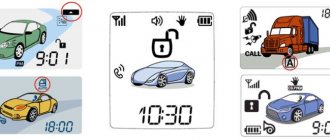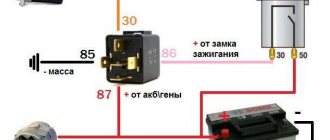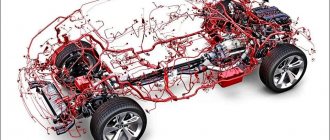Every driver, even with little driving experience, is familiar with the rule of the right hand or the obstacle that occurs on the right side. This rule from the traffic rules is given an important place; moreover, the obstacle on the right is even considered the main postulate on the road.
When observing this canon, controversial issues may arise that a novice driver may not be aware of. We have taken the liberty of telling everything that has to do with this type of obstacle. At the end of this conversation, you will have no doubts regarding actions regarding other road users in unregulated areas.
Definition of the concept
First, we need to understand the concept of “interference on the right.” This information will allow you to clearly understand the essence of the further conversation and not confuse this rule with other concepts from the traffic rules. This concept is relevant on those sections of the road that are not equipped with regulatory signs.
The interference on the right quotes paragraph from the traffic rules numbered 8.9. The essence of this point boils down to the following: the absence of any regulated form, which is aimed at regulating the sequence of vehicle passage, provides for drivers to pass, taking into account the presence of obstacles on the right side. You need to clearly understand that the car that acts as that very obstacle on the right must be allowed through. Only after this can you start moving, provided there are no other cars on the right side.
Now let's deal with an equally important question, which often becomes a stumbling block - how to determine the interference on the right. When approaching a section of the road that is not equipped with regulatory signs, you must ensure that they are completely absent. Standing at a fork, pay attention to the vehicles that are on the right side relative to your car. Such road users will be considered an obstacle that must be given the right to travel.
If the lines of movement (yours and the car on the right) coincide, you will have to give way and wait for the other car to complete the maneuver. Only if there are no cars on the right side can you continue driving.
We have figured out what the interference on the right means and in theory everything seems to be clear. In practice, a number of controversial situations arise that can confuse. These situations need to be studied in detail so that problems do not arise on the road.
Penalty for violating the “third hand” rule
The table of penalties literally does not contain an article for violating the “interference on the right” rule. But if the requirement to cede the right of priority passage in accordance with the “Interference on the right” rule is not met, certain articles of the Code of Administrative Offenses come into force:
- Article 12.13, part 2 – if the violation occurred at an intersection, the penalty is a fine of 1000 rubles;
- Art. 12.14.h. 3 – violation of the rules of priority travel, with the exception of Art. 12.13 p.m. 3 and 12.17 of the Code of Administrative Offences, as punishment a verbal warning is issued or a fine of 500 rubles is issued;
- Art. 12.17 – it talks about not granting the right of way to a route vehicle or a car with flashing lights on, special. sound signal (siren), external color schemes, here a fine of 500 to 3,000 rubles is issued, or deprivation of the right to drive for 1-3 months, depending on the complexity of the case.
Thus, in the APN protocol, the traffic police inspector will indicate a violation of a specific clause and issue a fine under the appropriate clause of the Code of Administrative Offenses for failure to comply with the requirement to provide priority travel.
The “Interference on the right” rule applies only in cases where the case does not fit within the framework described in the traffic rules.
Examples of possible interference on the right
It's time to figure out how interference on the right works in practice. We have collected some subtleties and exceptions:
- when leaving a dirt road, the car is not mistaken for an obstacle that must be passed, this type of road is always considered secondary;
- the turned on turn does not play any significance and does not affect the situation that develops on the road; regardless of the turn, the car must be allowed to pass.
Next we will study common situations in which the validity of the rule seems controversial. You must know who must give way, for example, at an intersection or when changing lanes. If you correctly apply this information in practice, you will be able to avoid emergency situations and unpleasant consequences.
What is an obstacle on the right and who, according to the rules, must give way
Immediately after receiving a driver's license, a beginner is guided by the most important driving rules. He learns some of them during his studies, others he learns from the experience of communicating with experienced motorists. The right-hand rule is recognized among many drivers.
How to understand the rule
This concept hides a requirement that obliges the driver to let the car on the right pass. Despite its apparent simplicity, it is often violated.
For example, this happens in large parking lots, where parking spaces are located in rows, between which traffic lanes run perpendicularly. Being on such a road, many drivers feel like they are on the main road, so they ignore those who pull out of parking spaces on the side.
In fact, according to traffic rules, the entire parking area is of equal importance. There is no main or secondary road here. In such circumstances, one should rely on clause 8.9 of the traffic rules, according to which, when crossing the trajectories of two vehicles, one must adhere to the “right hand” rule.
Thus, the driver on the central path must give way to a car leaving the parking lot.
Adjacent territories, residential areas and exit roads passing through them are secondary in relation to the city highways passing by. Therefore, here drivers driving in the central part do not need to let those leaving the surrounding areas pass.
You need to let the car on the right pass if the roads are equivalent.
When to use
If in a city all intersecting directions are marked with the help of road signs and markings, then no difficulties arise with the right-hand rule. In practice, drivers are often faced with incomprehensible situations that can cause short-term confusion. This is aggravated by some stereotypes of perception of motorists. For example, many people think that at a T-junction, driving straight ahead has priority. In fact, this is far from the case.
When the roadway narrows, the trajectories of vehicles usually intersect. If two equal vehicles are moving in parallel, then one of them must give way to the other.
In the absence of signs and markings, strange situations may arise here. Often the driver of the left lane feels his advantage and simply pushes the car out on the right. In fact, here you need to focus on the obstacle on the right, since the cars are on equal terms.
The right-hand rule works in the absence of road signs, markings, or traffic lights that determine the order of travel.
It should be remembered that trams have priority in almost all cases of crossing vehicle trajectories. The only exception is their departure from the depot, since here we are talking about the adjacent territory.
Thus, it is advisable to always yield to cars that are on the right. Most often, traffic trajectories intersect at intersections.
Problems at intersections
Obstruction on the right at an intersection is a common situation that a driver can encounter several times a day. It is imperative to know the rules for crossing uncontrolled intersections. This knowledge will help you navigate the road freely, not create problems for other road users and avoid accidents.
At intersections, the right-hand rule works as follows: if drivers have equal opportunities, they need to let through vehicles that are on the right side. The difficulty is associated with the dynamics of traffic, which is typical for large cities with a lot of transport. There are situations when this rule does not apply. We'll talk about them further.
Driving on uneven roads
Paragraph 13.10 of the traffic rules talks about the standards for passing unequal intersections. This rule states that when the main road at an intersection changes direction, drivers traveling along the main road are guided by the rules for crossing intersections of equivalent roads. The same standards apply to drivers driving on secondary roads.
If the main road changes direction, then traffic is regulated by the “Interference on the right” rule. The same rule applies to traffic if the following signs are installed: “Main road”, “Driving without stopping is prohibited”, “Give way”.
Changing lanes
No less controversial situations arise when changing lanes on a multi-lane road. A car is not always mistaken for an obstacle on the right when changing lanes. If we turn to the traffic rules, we will see the following interpretation: when performing a lane change maneuver, the driver is obliged to provide the opportunity for passage to those vehicles that are moving in the same direction and do not change direction. If two vehicles that are moving in parallel relative to each other simultaneously make a maneuver to change lanes, then priority should be given to the car located on the right side.
Applying the rule when changing lanes
Rebuildings can be divided into 2 groups:
- Simple (only one vehicle is rebuilt);
- Complex or mutual, the name speaks for itself; in this case, a simultaneous reconstruction of the vehicle occurs.
When simply rearranging questions, no rule always dictates that you give way to the participant who changes something. And here the one who is rebuilding gives way. But with simultaneous (mutual) restructuring, the order is determined by applying the rule of interference from the right.
Where does the right hand rule not apply?
This rule does not always apply. There are a number of situations in which the right-hand rule loses its validity. All of them are described below:
- different statuses of road users;
- This rule does not apply to rail transport; it is always allowed through;
- unequal priorities regarding the positions of the participants, which falls under the regulation of signs, traffic lights or traffic controllers;
- starting to move or reverse;
- following an additional traffic light sign;
- when entering the bridge, the driver allows cars that are already moving along it to pass; in this case, the transport is not perceived as an obstacle.
We managed to consider a lot of things, including in what cases this rule does not apply. This information is not only required to be studied, it must be remembered and never forgotten. It should be stored in your head, and the principles of following the rule should be carried out automatically. In this case, you will never be the culprit of an accident; it can only happen because of another ignorant driver. It’s not for nothing that an obstacle on the right is considered the main rule in traffic rules.
Equivalent road
Paragraph 13.11 of the traffic rules for uncontrolled intersections states that drivers of trackless vehicles are required to give way to mechanical vehicles approaching from the right. This traffic rule “Interference on the right” is applicable only at unregulated intersections (crossroads) of equivalent roads. This concept includes all intersections where there are no traffic controllers, traffic lights, or the latter do not work.
An intersection is considered equivalent in the following cases:
- The sign “Intersection of equivalent roads” has been installed.
- The sign “End of the main road” has been installed.
- There are no priority signs before the intersection, and intersecting roads have identical surfaces. An example would be intersections without signs for field roads or asphalt roads.
In cases where the intersection is unregulated and equal, then the traffic rules “Interference on the right” apply.
Where does the rule apply and when does it apply?
Let's turn directly to the traffic rules. Let's take a few basic points from which we can build an analysis of all typical situations.
| Russian Federation Traffic Regulations clause | Explanation |
| 8.4 | When changing lanes in the ranks of passing traffic, those vehicles that move without changing direction have an advantage. When several vehicles are maneuvering at the same time, those on the right have the advantage. |
| 8.9 | When the trajectories of two vehicles intersect, if there are no Russian traffic regulations regulating this situation, the one on the right has the advantage. |
| 13.11 | At equal intersections, in the absence of traffic regulations, those on the right have the advantage. The exception is roundabouts. |
| 13.10 | At unequal intersections, traffic follows the main roads, i.e. without a main-secondary maneuver, it is regulated by the rules of an equivalent intersection. The same is true when driving only on secondary roads, without going to the main road. |
The four points listed will be enough for us to use examples to determine whose cars have an advantage in specific situations.
Source
Avoiding obstacles on the left
As you know, you can only go around obstacles on the right side, according to traffic rules. Often, when there is heavy rainfall or forest cover, the driver is limited in movement and is not able to drive through without breaking the rules. In this case, a special sign is installed allowing the obstacle to be avoided on the left 4. 4 2.
This sign is installed to inform the driver of the vehicle in which direction it is allowed to continue driving. This is written clearly in the traffic rules.
If this sign has already been seen on the road, then passing on the right is prohibited, and for violating the sign you will face a significant fine.
Sign to avoid obstacles on the left 4. 4 2
This sign is often installed near improvement projects or when providing public works and transport associated with them. It can also be found during road repair work, when there is no way to pass on the right.
When a vehicle is moving with a solid line and at this interval the driver may encounter a sign allowing you to bypass an obstacle on the left, then you need to hold on to this sign and follow its instructions. These instructions make it possible to ignore the rules completely, but it is important to return to the starting side after passing the obstacle in order to protect yourself from awkward situations.
Simultaneous lane change
The traffic rules about changing lanes say the following:
“When changing lanes, the driver must give way to vehicles moving in the same direction without changing direction. When simultaneously changing lanes of vehicles moving in the same direction, the driver must give way to the vehicle on the right.”
Let's look at everything in order, because... There can be many cases of rebuilding.
1. You are driving in your lane, and a car is changing lanes from the adjacent lane. You are not obliged to yield to him, regardless of whether the car is moving to your right or left. You can do this only of your own free will. The “interference from the right” rule does not apply.
2. You want to change lanes into the next lane. Other cars do not change lanes. In this case, you will have to wait until the cars in the adjacent lane run out. The “interference from the right” rule does not apply.
3. You change lanes to the lane that is on your left. The car in the left lane is also changing lanes. According to traffic rules, a car must give way to you, and this does not depend on where it changes lanes. The “interference from the right” rule applies. Although in this situation you have an advantage, rush into the left lane shouting “Hurray! The right hand interference rule applies!” not worth it. It’s better to wait a little and make sure that they really give way to you.
4. You change lanes to the lane that is on your right. A car in the right lane is changing lanes. In this case, you must give way. The “interference from the right” rule applies.
Bypassing a continuous line
Nowadays, situations such as blocking of some sections of the road often arise due to various reasons. The bus punctured a tire, there was an accident, repair work and much more. And then the driver begins to panic and turn off the vehicle. And wait for the problem to be resolved in this area, or jump through the solid line. According to statistics, most vehicle owners choose option number two.
But think about it: generally, traffic police officers regard crossing a solid line as a gross violation of traffic rules. Which may entail a small fine.
Unfortunately, the traffic rules do not have a clear concept of what detour or overtaking is. Here you will need to understand and take into account the code of administrative violations, namely Article 12. 15. In this section it will be written in detail that a detour in such cases can be considered as a maneuver, due to an obstacle due to which it is impossible to continue the movement of traffic. Please note that driving on your side is prohibited. Even at a low speed, then this action will be considered as overtaking and a traffic violation.
How to properly avoid obstacles on the left or right
And so in some situations you can come across a sign 4. 2 3 detour around obstacles on the left and right. This sign will give the driver the opportunity to choose his own route for further travel.
This can often be found when repairing the roadway, or roads in the middle of the street. It is recommended to choose the right side to go around the obstacle, but still this sign gives you the right to choose yourself, but it is still better to go around on the left side as a last resort. Of course, there will be no fine, this serves to prevent an accident in the oncoming lane.
It is important to understand that traffic violations can lead to serious injury and death.
When the rule doesn't work
There are a few exceptions where the right-hand rule does not apply. In such cases, in order to correctly drive through intersections and other areas, you need to prioritize traffic:
- Pedestrians always have priority over cars and other vehicles. If there is a crossing, you must give way.
- Trams and any other rail vehicles pass through intersections first if there are no traffic lights or priority signs.
- Crossing uneven roads. The advantage always belongs to those who move along the main road, and only then can the rest move.
- Exits from secondary roads, courtyards, gas stations, etc. cannot be considered a full-fledged intersection, so when moving from them you need to give way to everyone.
- When turning into a roundabout, give way to everyone moving around the roundabout. In this case, the right-hand rule does not work.
Important! The presence of any signs or other indicators regulating the rules of travel automatically cancels the principle of obstruction on the right.
If there is a traffic controller at the intersection of equivalent roads, he determines the order of passage. You should follow his instructions and not move without a command, even if the road is clear.
Using the rule of interference on the right is not difficult; it helps to quickly navigate the order of travel on equivalent roads and determine who has priority when changing lanes. The main thing is to remember in which cases this principle does not apply, so as not to create emergency situations and ensure traffic safety.
Right hand interference or right hand rule - who lets whom through, and in what situations?
Every driver, even with little driving experience, is familiar with the rule of the right hand or the obstacle that occurs on the right side. This rule from the traffic rules is given an important place; moreover, the obstacle on the right is even considered the main postulate on the road.
When observing this canon, controversial issues may arise that a novice driver may not be aware of. We have taken the liberty of telling everything that has to do with this type of obstacle. At the end of this conversation, you will have no doubts regarding actions regarding other road users in unregulated areas.
Important Tips
People moving along an additional route or leaving a residential yard must give way to everyone.
It is advisable to first establish visual interaction with the driver moving on the left side.
In this case, it will be clear what his subsequent manipulations will be. This is not a special universal rule, it is simply a way to show drivers your intention.
If the driver does not react at all, if the speed of his car does not decrease, you must definitely let him pass.
Particularly unbalanced drivers try to teach such stubborn people a lesson and drive directly. You shouldn't do that. This will lead to an emergency. You shouldn’t waste your nerves, time and health trying to prove something.
Rule of the right hand in traffic rules in the presence of obstacles on the right
The expression “interference on the right” is known even to those who are not drivers at all. This norm is presented as a kind of fundamental rule of the road, around which everything else is built. However, those who looked into the traffic rules of the Russian Federation could not find any “right-hand rules” there. At least nothing that would be called exactly that or similar.
Nevertheless, such a rule does exist and is a fairly important component of general norms. Where to look for an obstacle on the right and how to use these traffic rules requirements in practice - we will consider in detail in this article.










